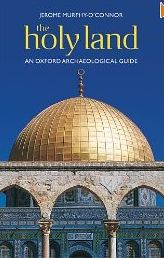
The best guide to Israel for a Christian tour is The Holy Land: An Oxford Archaeological Guide by Jerome Murphy-O’Connor (Fifth Edition; Oxford, 2008, 544 pages, $37.95, Kindle Version $13.50). I cannot imagine visiting Israel on a tour without this book in my travel bag. The book is divided into two parts. The first 173 pages covers Jerusalem, rest of the book covers archaeological sites in the rest of the Land. As should be obvious from the title of the book, this is a guide to archaeological sites, not a guide for pilgrims. While most of the Holy Sites are included, they are described in terms of their history and archaeology rather than their religious significance.
Two general features are found throughout the text. Murphy-O’Connor has “rated” sites with either two stars, one star or no stars in order to indicate locations that must be seen on a visit to Israel. This is a highly subjective system and should not to imply that a non-starred site can be skipped. His point is that starred locations are should not be missed. For example, Qumran and Masada receive two stars, Megiddo and Capernaum receive one star, and En Gedi no star. To me, there is no way I could lead a tour group without visiting all of these sites. While En Gedi is always a favorite with my groups, most people are disappointed with Qumran (although the buffet is great!)
A second feature is the use of side-bars with text from ancient authorities (Inscriptions, Josephus, Maimonides, the Bible, etc.) These ancient descriptions are helpful when reading the archeological descriptions. In some cases, side-bars explain key terms (Who were the Mamluks?)
The section on Jerusalem is divided by area of the Old City, beginning with the walls and gates and progressing through the quarters of the Old City to Haram esh-Sarif (Temple Mount), excavations at the Western Wall plaza, Mount Sion, The City of David, the Kidron, the Tombs in the Valley, and the Mount of Olives. Murphy-O’Connor covers a few locations outside the Old City as well. There are dozens of line-drawn maps and charts of archaeological sites along with black and white photographs and other illustrations. These small maps can be used to orient oneself when visiting a location. For example, the map of the Western and Southern wall excavations has 23 points of interest marked on the map, all of which receive a brief description ion the text. Virtually everything of interest is marked on these small yet clear maps.
An extra value of the guide is the inclusion of hours of operation for locations as well as telephone numbers. Murphy-O’Connor provides advice on whether arrangements need to be made for a group or if there is I am amazed at the minor locations which are briefly included in the Guide, including places like the Convent of the Olive Tree and the Monastery of the Flagellation.
The second section is a “Guide to the Land” and is arranged alphabetically. Like the section on the Old City, this section combines useful information on make the most of one’s visit to Israel with excellent illustrations and maps. The map of Masada is particularly good considering it is on a single page. Most archaeology sites describe has a site map indicating points of interest. This section also has entries for regions (Golan, Negev), Peoples (Druze, Samaritans, Nabateans) and historical events (Crusades).
If there is any criticism to be of this book is that it is out of date already. Work in the City of David has been constant for the last few years, rendering this handbook a bit out of date. The material on the Southern Wall excavations is still good since that area has not has any recent excavations. My copy of the Oxford Archaeological Guide is well worn and marked with notes made on my tours. I have photocopied maps from the Guide and taped them into my Moleskin journal for note-taking from other sources.
I eagerly await the Sixth Edition of this essential Guide to the archaeology of Israel!